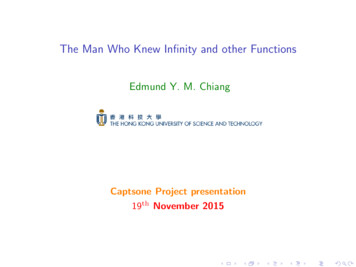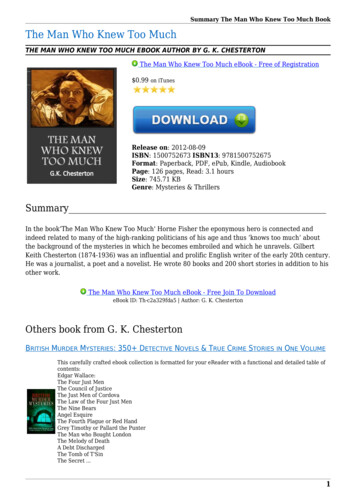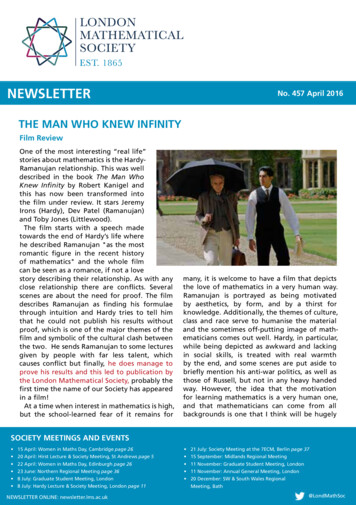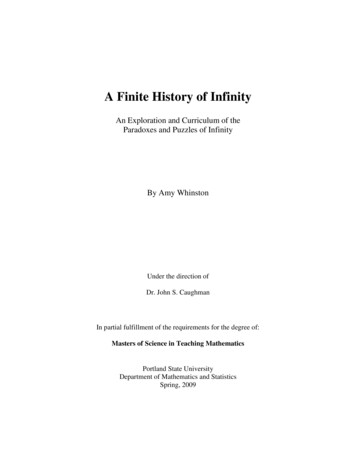
Transcription
The Man Who Knew Infinity and other FunctionsEdmund Y. M. ChiangCaptsone Project presentation19th November 2015
A filmEarly LifeG. H. HardyRogers-Ramanujan identitiesSome q calculusOutlineA filmEarly LifeG. H. HardyRogers-Ramanujan identitiesSome q calculusRevision on Binomial theorem (Andrews, Askey & Roy 1999)q Binomial Identitiesq Binomial coefficientsExercisesExercises
A filmEarly LifeG. H. HardyRogers-Ramanujan identitiesSome q calculusZurich Film Festival (2015)Figure: Zurich Film Festival Opening FilmExercises
A filmEarly LifeG. H. HardyRogers-Ramanujan identitiesSome q calculusThe Man Who Knew Infinity (2015)Figure: Zurich Film Festival Opening FilmExercises
A filmEarly LifeG. H. HardyRogers-Ramanujan identitiesSome q calculusThe Man Who Knew Infinity film (2015)Exercises
A filmEarly LifeG. H. HardyRogers-Ramanujan identitiesSome q calculusRobert Kanigel’s book (1991)Exercises
A filmEarly LifeG. H. HardyRogers-Ramanujan identitiesSome q calculusExercisesWho is Srinivasa Ramanujan? Ramanujan was born on 22nd December 1887 in Erode, asmall town about 250 miles southwest of Chennai (Madras),India. He died on 26th April 1919 when he was 32 years old. He wrote some of the most famous letters in the history ofmathematics. He wrote down thousands of identities. He is generally acknowledged as one of the greatest Indianmathematicians throughout the history. He is ranked along with L. Euler and K. Jacobi. Some evensaid Gauss. There is a novel called The Man Who Knew Infinity by RobertKanigel (1991), and yet few understood his mathematics. He worked in Number theory, Analysis (partition functions,elliptic functions, continued fraction, etc) yet he only receivedlittle formal education.
A filmEarly LifeG. H. HardyRogers-Ramanujan identitiesSome q calculusExercisesWho is Srinivasa Ramanujan? Ramanujan was born on 22nd December 1887 in Erode, asmall town about 250 miles southwest of Chennai (Madras),India. He died on 26th April 1919 when he was 32 years old. He wrote some of the most famous letters in the history ofmathematics. He wrote down thousands of identities. He is generally acknowledged as one of the greatest Indianmathematicians throughout the history. He is ranked along with L. Euler and K. Jacobi. Some evensaid Gauss. There is a novel called The Man Who Knew Infinity by RobertKanigel (1991), and yet few understood his mathematics. He worked in Number theory, Analysis (partition functions,elliptic functions, continued fraction, etc) yet he only receivedlittle formal education.
A filmEarly LifeG. H. HardyRogers-Ramanujan identitiesSome q calculusExercisesWho is Srinivasa Ramanujan? Ramanujan was born on 22nd December 1887 in Erode, asmall town about 250 miles southwest of Chennai (Madras),India. He died on 26th April 1919 when he was 32 years old. He wrote some of the most famous letters in the history ofmathematics. He wrote down thousands of identities. He is generally acknowledged as one of the greatest Indianmathematicians throughout the history. He is ranked along with L. Euler and K. Jacobi. Some evensaid Gauss. There is a novel called The Man Who Knew Infinity by RobertKanigel (1991), and yet few understood his mathematics. He worked in Number theory, Analysis (partition functions,elliptic functions, continued fraction, etc) yet he only receivedlittle formal education.
A filmEarly LifeG. H. HardyRogers-Ramanujan identitiesSome q calculusExercisesWho is Srinivasa Ramanujan? Ramanujan was born on 22nd December 1887 in Erode, asmall town about 250 miles southwest of Chennai (Madras),India. He died on 26th April 1919 when he was 32 years old. He wrote some of the most famous letters in the history ofmathematics. He wrote down thousands of identities. He is generally acknowledged as one of the greatest Indianmathematicians throughout the history. He is ranked along with L. Euler and K. Jacobi. Some evensaid Gauss. There is a novel called The Man Who Knew Infinity by RobertKanigel (1991), and yet few understood his mathematics. He worked in Number theory, Analysis (partition functions,elliptic functions, continued fraction, etc) yet he only receivedlittle formal education.
A filmEarly LifeG. H. HardyRogers-Ramanujan identitiesSome q calculusExercisesWho is Srinivasa Ramanujan? Ramanujan was born on 22nd December 1887 in Erode, asmall town about 250 miles southwest of Chennai (Madras),India. He died on 26th April 1919 when he was 32 years old. He wrote some of the most famous letters in the history ofmathematics. He wrote down thousands of identities. He is generally acknowledged as one of the greatest Indianmathematicians throughout the history. He is ranked along with L. Euler and K. Jacobi. Some evensaid Gauss. There is a novel called The Man Who Knew Infinity by RobertKanigel (1991), and yet few understood his mathematics. He worked in Number theory, Analysis (partition functions,elliptic functions, continued fraction, etc) yet he only receivedlittle formal education.
A filmEarly LifeG. H. HardyRogers-Ramanujan identitiesSome q calculusExercisesWho is Srinivasa Ramanujan? Ramanujan was born on 22nd December 1887 in Erode, asmall town about 250 miles southwest of Chennai (Madras),India. He died on 26th April 1919 when he was 32 years old. He wrote some of the most famous letters in the history ofmathematics. He wrote down thousands of identities. He is generally acknowledged as one of the greatest Indianmathematicians throughout the history. He is ranked along with L. Euler and K. Jacobi. Some evensaid Gauss. There is a novel called The Man Who Knew Infinity by RobertKanigel (1991), and yet few understood his mathematics. He worked in Number theory, Analysis (partition functions,elliptic functions, continued fraction, etc) yet he only receivedlittle formal education.
A filmEarly LifeG. H. HardyRogers-Ramanujan identitiesSome q calculusExercisesEarly Life (I) 1 year old: moved to a Hindu town Kumbakonam (Pop:50,000) 170 miles south of Chennai, where his father was acloth merchant’s clerk. Entered school at five years old. 11 years old: Ramanujan did well in all school subjects in atown high school, especially in mathematics. 13 years old: Ramanujan started to research on geometricseries. He had tried to solve quartic equation. Things take on a dramatic turn after a friend lent Ramanujana Government College library’s copy of G. S. Carr’s“Synopsis of Elementary Results in Pure Mathematics” Hardy’s comment:“. It contains enunciation of 6,165 theorems, systematically andquite scientifically arranged, with proofs which are often little morethan cross-references .”
A filmEarly LifeG. H. HardyRogers-Ramanujan identitiesSome q calculusExercisesEarly Life (I) 1 year old: moved to a Hindu town Kumbakonam (Pop:50,000) 170 miles south of Chennai, where his father was acloth merchant’s clerk. Entered school at five years old. 11 years old: Ramanujan did well in all school subjects in atown high school, especially in mathematics. 13 years old: Ramanujan started to research on geometricseries. He had tried to solve quartic equation. Things take on a dramatic turn after a friend lent Ramanujana Government College library’s copy of G. S. Carr’s“Synopsis of Elementary Results in Pure Mathematics” Hardy’s comment:“. It contains enunciation of 6,165 theorems, systematically andquite scientifically arranged, with proofs which are often little morethan cross-references .”
A filmEarly LifeG. H. HardyRogers-Ramanujan identitiesSome q calculusExercisesEarly Life (I) 1 year old: moved to a Hindu town Kumbakonam (Pop:50,000) 170 miles south of Chennai, where his father was acloth merchant’s clerk. Entered school at five years old. 11 years old: Ramanujan did well in all school subjects in atown high school, especially in mathematics. 13 years old: Ramanujan started to research on geometricseries. He had tried to solve quartic equation. Things take on a dramatic turn after a friend lent Ramanujana Government College library’s copy of G. S. Carr’s“Synopsis of Elementary Results in Pure Mathematics” Hardy’s comment:“. It contains enunciation of 6,165 theorems, systematically andquite scientifically arranged, with proofs which are often little morethan cross-references .”
A filmEarly LifeG. H. HardyRogers-Ramanujan identitiesSome q calculusExercisesEarly Life (I) 1 year old: moved to a Hindu town Kumbakonam (Pop:50,000) 170 miles south of Chennai, where his father was acloth merchant’s clerk. Entered school at five years old. 11 years old: Ramanujan did well in all school subjects in atown high school, especially in mathematics. 13 years old: Ramanujan started to research on geometricseries. He had tried to solve quartic equation. Things take on a dramatic turn after a friend lent Ramanujana Government College library’s copy of G. S. Carr’s“Synopsis of Elementary Results in Pure Mathematics” Hardy’s comment:“. It contains enunciation of 6,165 theorems, systematically andquite scientifically arranged, with proofs which are often little morethan cross-references .”
A filmEarly LifeG. H. HardyRogers-Ramanujan identitiesSome q calculusExercisesEarly Life (II) Ramanujan became addicted to mathematics and startrecording his own results in Carr’s format. By 1904, i.e., 17 years old, Ramanujan had begun investigatedthe seriesplaces.P1nand calculated Euler’s constant to 15 decimal The same year his school discontinued his scholarship for poorperformance of other subjects. In 1906, he was given a second scholarship to attendPachaiyappa’s College in Madras in preparing for entering theUniversity of Madras. But he failed all subjects exceptmathematics.
A filmEarly LifeG. H. HardyRogers-Ramanujan identitiesSome q calculusExercisesEarly Life (II) Ramanujan became addicted to mathematics and startrecording his own results in Carr’s format. By 1904, i.e., 17 years old, Ramanujan had begun investigatedthe seriesplaces.P1nand calculated Euler’s constant to 15 decimal The same year his school discontinued his scholarship for poorperformance of other subjects. In 1906, he was given a second scholarship to attendPachaiyappa’s College in Madras in preparing for entering theUniversity of Madras. But he failed all subjects exceptmathematics.
A filmEarly LifeG. H. HardyRogers-Ramanujan identitiesSome q calculusExercisesEarly Life (II) Ramanujan became addicted to mathematics and startrecording his own results in Carr’s format. By 1904, i.e., 17 years old, Ramanujan had begun investigatedthe seriesplaces.P1nand calculated Euler’s constant to 15 decimal The same year his school discontinued his scholarship for poorperformance of other subjects. In 1906, he was given a second scholarship to attendPachaiyappa’s College in Madras in preparing for entering theUniversity of Madras. But he failed all subjects exceptmathematics.
A filmEarly LifeG. H. HardyRogers-Ramanujan identitiesG. H. HardyFigure: 1877-1947Some q calculusExercises
A filmEarly LifeG. H. HardyRogers-Ramanujan identitiesSome q calculusExercisesA day morning in January 1913One morning in 1913, he found, among the letters on his breakfasttable, a large untidy envelope decorated with Indian stamps. Whenhe opened it . he found line after line of symbols. He glanced atthem without enthusiasm. He was by this time . a world famousmathematician, and . he was accustomed to receivingmanuscripts from stangers. The script appeared to consist oftheorems, most of them wild or fantistic . There were no proofsof any kind . A fraud or genius ? .
A filmEarly LifeG. H. HardyRogers-Ramanujan identitiesSome q calculusExercisesThe first letterIn 1913 (16th January) Ramanujan wrote to G. H. Hardy. Heintroduced himself and his work as“Dear Sir, I beg to introduce myself to you as a clerk in theAccounts Department . on a salary of only 20 per annum . Ihave had no university education but I have undergone theordinary school course. After leaving school I have been employingthe spare time at my disposal to work at mathematics. I have nottrodden through the conventional regular course which is followedin a university course, but I am striking out a new path for myself.I have made a special investigation of divergent series in generaland the results I get are termed by the local mathematicians as’startling’.”
A filmEarly LifeG. H. HardyRogers-Ramanujan identitiesSome q calculusExercisesThe first letterIn 1913 (16th January) Ramanujan wrote to G. H. Hardy. Heintroduced himself and his work as“Dear Sir, I beg to introduce myself to you as a clerk in theAccounts Department . on a salary of only 20 per annum . Ihave had no university education but I have undergone theordinary school course. After leaving school I have been employingthe spare time at my disposal to work at mathematics. I have nottrodden through the conventional regular course which is followedin a university course, but I am striking out a new path for myself.I have made a special investigation of divergent series in generaland the results I get are termed by the local mathematicians as’startling’.”
A filmEarly LifeG. H. HardyRogers-Ramanujan identitiesSome q calculusExercisesHardy’s reaction “His letters contained the bare statement of about 120theorems. Several of them were known already, others werenot. Of these, some I could prove (after harder work than Ihad expected) while others fairly blew me away. I had neverseen the like! Only a mathematician of the highest class couldhave written them. They had to be true, for if they were not,no one would have the imagination to invent them. A fewwere definitely wrong. But that only added credence to myfeeling that the writer was totally honest, since greatmathematicians are commoner than frauds of the incredibleskill that would be needed to create such a letter. ” He decided that Ramanujan was, in terms of . genus ofGauss and Euler . (Partially taken from Hardy’s “AMathematician’s Apology”)
A filmEarly LifeG. H. HardyRogers-Ramanujan identitiesSome q calculusExercisesHardy’s reaction “His letters contained the bare statement of about 120theorems. Several of them were known already, others werenot. Of these, some I could prove (after harder work than Ihad expected) while others fairly blew me away. I had neverseen the like! Only a mathematician of the highest class couldhave written them. They had to be true, for if they were not,no one would have the imagination to invent them. A fewwere definitely wrong. But that only added credence to myfeeling that the writer was totally honest, since greatmathematicians are commoner than frauds of the incredibleskill that would be needed to create such a letter. ” He decided that Ramanujan was, in terms of . genus ofGauss and Euler . (Partially taken from Hardy’s “AMathematician’s Apology”)
A filmEarly LifeG. H. HardyRogers-Ramanujan identitiesSome q calculusExercisesHardy’s reaction “His letters contained the bare statement of about 120theorems. Several of them were known already, others werenot. Of these, some I could prove (after harder work than Ihad expected) while others fairly blew me away. I had neverseen the like! Only a mathematician of the highest class couldhave written them. They had to be true, for if they were not,no one would have the imagination to invent them. A fewwere definitely wrong. But that only added credence to myfeeling that the writer was totally honest, since greatmathematicians are commoner than frauds of the incredibleskill that would be needed to create such a letter. ” He decided that Ramanujan was, in terms of . genus ofGauss and Euler . (Partially taken from Hardy’s “AMathematician’s Apology”)
A filmEarly LifeG. H. HardyRogers-Ramanujan identitiesSome q calculusExercisesHardy’s reaction “His letters contained the bare statement of about 120theorems. Several of them were known already, others werenot. Of these, some I could prove (after harder work than Ihad expected) while others fairly blew me away. I had neverseen the like! Only a mathematician of the highest class couldhave written them. They had to be true, for if they were not,no one would have the imagination to invent them. A fewwere definitely wrong. But that only added credence to myfeeling that the writer was totally honest, since greatmathematicians are commoner than frauds of the incredibleskill that would be needed to create such a letter. ” He decided that Ramanujan was, in terms of . genus ofGauss and Euler . (Partially taken from Hardy’s “AMathematician’s Apology”)
A filmEarly LifeG. H. HardyRogers-Ramanujan identitiesAbout 120 formulae IFigure: 1913 (B. Berndt)Some q calculusExercises
A filmEarly LifeG. H. HardyRogers-Ramanujan identitiesAbout 120 formulae IIFigure: 1913 (B. Berndt)Some q calculusExercises
A filmEarly LifeG. H. HardyRogers-Ramanujan identitiesAbout 120 formulae IIIFigure: 1913 (B. Berndt)Some q calculusExercises
A filmEarly LifeG. H. HardyRogers-Ramanujan identitiesSome q calculusExercisesRamanujan was sick During his five-year stay in Cambridge, which unfortunatelyoverlapped with the first World War years, he published 21papers, five of which were in collaboration with Hardy. Ramanujan fell seriously ill in 1917 and his doctors feared thathe would die. This could be due to his earlier contraction ofdysentery. Unless adequately treated, the infection ispermanent. The illness is difficult to diagnose. Ramanujan was sick since the end of his first winter in 1915and was in and out of hospital and nursing home before hereturned to India in 1919 after the end of the first world war. Ramanujan dead on the 26 April 1920.
A filmEarly LifeG. H. HardyRogers-Ramanujan identitiesSome q calculusExercisesRamanujan was sick During his five-year stay in Cambridge, which unfortunatelyoverlapped with the first World War years, he published 21papers, five of which were in collaboration with Hardy. Ramanujan fell seriously ill in 1917 and his doctors feared thathe would die. This could be due to his earlier contraction ofdysentery. Unless adequately treated, the infection ispermanent. The illness is difficult to diagnose. Ramanujan was sick since the end of his first winter in 1915and was in and out of hospital and nursing home before hereturned to India in 1919 after the end of the first world war. Ramanujan dead on the 26 April 1920.
A filmEarly LifeG. H. HardyRogers-Ramanujan identitiesSome q calculusExercisesRamanujan was sick During his five-year stay in Cambridge, which unfortunatelyoverlapped with the first World War years, he published 21papers, five of which were in collaboration with Hardy. Ramanujan fell seriously ill in 1917 and his doctors feared thathe would die. This could be due to his earlier contraction ofdysentery. Unless adequately treated, the infection ispermanent. The illness is difficult to diagnose. Ramanujan was sick since the end of his first winter in 1915and was in and out of hospital and nursing home before hereturned to India in 1919 after the end of the first world war. Ramanujan dead on the 26 April 1920.
A filmEarly LifeG. H. HardyRogers-Ramanujan identitiesSome q calculusExercisesRamanujan was sick During his five-year stay in Cambridge, which unfortunatelyoverlapped with the first World War years, he published 21papers, five of which were in collaboration with Hardy. Ramanujan fell seriously ill in 1917 and his doctors feared thathe would die. This could be due to his earlier contraction ofdysentery. Unless adequately treated, the infection ispermanent. The illness is difficult to diagnose. Ramanujan was sick since the end of his first winter in 1915and was in and out of hospital and nursing home before hereturned to India in 1919 after the end of the first world war. Ramanujan dead on the 26 April 1920.
A filmEarly LifeG. H. HardyRogers-Ramanujan identitiesSome q calculusBinomial Identity (I) (a b)2 (a b)(a b) a2 2ab b 2 (a b)3 (a b)(a b)(a b) a3 3a2 b 3ab 2 b 3 (a b)4 (a b)(a b)(a b)(a b) a4 4a3 b 6a2 b 2 4ab 3 b 4 (a b)5 (a b)(a b)(a b)(a b)(a b) a5 5a4 b 10a3 b 2 10a2 b 3 5ab 4 b 5Exercises
A filmEarly LifeG. H. HardyRogers-Ramanujan identitiesSome q calculusBinomial Identity (II) n Xn n k k(x y ) xy .knk 0 nn!, k!(n k)!kk! k (k 1) · · · 2 1 55!5!5 4 3 2 1 1033!(5 3)!3! 2!(3 2 1)(2 1) Combinatorial interpretation: The total number of ways tochoose 3 objects out of 5 objects. So kn counts the total number of ways to choose k objectsout of n objects.Exercises
A filmEarly LifeG. H. HardyRogers-Ramanujan identitiesSome q calculusBinomial Identity (II) n Xn n k k(x y ) xy .knk 0 nn!, k!(n k)!kk! k (k 1) · · · 2 1 55!5!5 4 3 2 1 1033!(5 3)!3! 2!(3 2 1)(2 1) Combinatorial interpretation: The total number of ways tochoose 3 objects out of 5 objects. So kn counts the total number of ways to choose k objectsout of n objects.Exercises
A filmEarly LifeG. H. HardyRogers-Ramanujan identitiesSome q calculusBinomial Identity (II) n Xn n k k(x y ) xy .knk 0 nn!, k!(n k)!kk! k (k 1) · · · 2 1 55!5!5 4 3 2 1 1033!(5 3)!3! 2!(3 2 1)(2 1) Combinatorial interpretation: The total number of ways tochoose 3 objects out of 5 objects. So kn counts the total number of ways to choose k objectsout of n objects.Exercises
A filmEarly LifeG. H. HardyRogers-Ramanujan identitiesSome q calculusExercisesSome formulae I Let 0 q 1. We define (a; q)n (1 a)(1 aq)(1 aq 2 ) · · · (1 aq n 1 ) n 1Y(1 aq k ),k 0 (a; q) (1 a)(1 aq)(1 aq 2 ) · · · Y(1 aq k ),n 1k 0 The infinite product always converge, a necessary condition is(1 aq n 1 ) 1,as n We define (a; q)0 1. E.g. (q; q)n (1 q)(1 q 2 ) · · · (1 q)nn
A filmEarly LifeG. H. HardyRogers-Ramanujan identitiesSome q calculusExercisesSome formulae I Let 0 q 1. We define (a; q)n (1 a)(1 aq)(1 aq 2 ) · · · (1 aq n 1 ) n 1Y(1 aq k ),k 0 (a; q) (1 a)(1 aq)(1 aq 2 ) · · · Y(1 aq k ),n 1k 0 The infinite product always converge, a necessary condition is(1 aq n 1 ) 1,as n We define (a; q)0 1. E.g. (q; q)n (1 q)(1 q 2 ) · · · (1 q)nn
A filmEarly LifeG. H. HardyRogers-Ramanujan identitiesSome q calculusExercisesSome formulae I Let 0 q 1. We define (a; q)n (1 a)(1 aq)(1 aq 2 ) · · · (1 aq n 1 ) n 1Y(1 aq k ),k 0 (a; q) (1 a)(1 aq)(1 aq 2 ) · · · Y(1 aq k ),n 1k 0 The infinite product always converge, a necessary condition is(1 aq n 1 ) 1,as n We define (a; q)0 1. E.g. (q; q)n (1 q)(1 q 2 ) · · · (1 q)nn
A filmEarly LifeG. H. HardyRogers-Ramanujan identitiesSome q calculusExercisesSome formulae I Let 0 q 1. We define (a; q)n (1 a)(1 aq)(1 aq 2 ) · · · (1 aq n 1 ) n 1Y(1 aq k ),k 0 (a; q) (1 a)(1 aq)(1 aq 2 ) · · · Y(1 aq k ),n 1k 0 The infinite product always converge, a necessary condition is(1 aq n 1 ) 1,as n We define (a; q)0 1. E.g. (q; q)n (1 q)(1 q 2 ) · · · (1 q)nn
A filmEarly LifeG. H. HardyRogers-Ramanujan identitiesSome q calculusExercisesSome formulae II n 1 q q 2 · · · q n 1 1 qn,1 q k!q 1 q1 q 1 q21 q ···1 qk1 q : (q, ; q)k(1 q)k q binomial coefficient n!qn .k qk!q (n k)!q(a; q)n (1 a)(1 aq) · · · (1 aq n k 1 ) If x 1, then1 1 x x2 x3 · · ·1 x
A filmEarly LifeG. H. HardyRogers-Ramanujan identitiesSome q calculusRogers-Ramanujan Identities (1894, 1917, 1919)Let q 1: Xn 0andj 0 Xq n(n 1)n 0 2Yqn1 5j 1(q; q)n(1 q)(1 q 5j 4 )(q; q)n Yj 01(1 q 5j 2 )(1 q 5j 3 )where 0 q 1 and(q; q)n (1 q)(1 q 2 ) · · · (1 q n ),Binomial identityn Xn n k k(a b) ab .knk 0(q; q)0 1.Exercises
A filmEarly LifeG. H. HardyRogers-Ramanujan identitiesSome q calculusRogers-Ramanujan Identities (1894, 1917, 1919)Let q 1: Xn 0andj 0 Xq n(n 1)n 0 2Yqn1 5j 1(q; q)n(1 q)(1 q 5j 4 )(q; q)n Yj 01(1 q 5j 2 )(1 q 5j 3 )where 0 q 1 and(q; q)n (1 q)(1 q 2 ) · · · (1 q n ),Binomial identityn Xn n k k(a b) ab .knk 0(q; q)0 1.Exercises
A filmEarly LifeG. H. HardyRogers-Ramanujan identitiesSome q calculusExercisesVerification of the first identity (I) Yj 011 ···(1 q 5j 1 )(1 q 5j 4 )(1 q)(1 q 4 )(1 q 6 )(1 q 9 ) (1 q q 2 q 3 q 4 q 5 q 6 · · · ) (1 q 4 q 8 q 12 · · · ) (1 q 6 q 12 · · · ) ··· 1 q q 2 q 3 2q 4 2q 5 3q 6 · · · .
A filmEarly LifeG. H. HardyRogers-Ramanujan identitiesSome q calculusExercisesVerification of the first identity (II) Xn 02qn1qq4q9 ···(q; q)n(q; q)0 (q; q)1 (q; q)2 (q; q)3 1 qq4q9 ···2(1 q) (1 q)(1 q ) (1 q)(1 q 2 )(1 q 3 ) q(1 q q 2 q 3 q 4 q 5 q 6 · · · ) q 4 (1 q q 2 q 3 · · · )(1 q 2 q 4 · · · ) q 9 (1 q q 2 · · · )(1 q 2 q 4 · · · )(1 q 3 q 6 · · · ) ··· 1 q q 2 q 3 2q 4 2q 5 3q 6 3q 7 4q 8 · · · .
A filmEarly LifeG. H. HardyRogers-Ramanujan identitiesSome q calculusExercisesInterpretations of the Identities (I)Let N be a positive integer. Then we define a partition of N to beN s1 s2 · · · skso that N s1 s2 · · · sk . That is, the sj are just integerssmaller or equal to N. For example, let us consider N 4. Then4 1 1 1 1 2 1 1 2 2 3 1 4.Hence there are 5 different partitions of 4. The are denoted asvectors (1, 1, 1, 1), (2, 1, 1), (2, 2), (3, 1) and finally (4). Thenumbers in the vectors above are called the parts of the partitions.
A filmEarly LifeG. H. HardyRogers-Ramanujan identitiesSome q calculusExercisesInterpretations of the Identities (II)TheoremThe right-hand side of the first Rogers-Ramanujan identity givesthe partitions with parts congruent to 1 (mod 5) or congruent to4 (mod 5).TheoremThe left-hand side of the first Rogers-Ramanujan identity gives thepartitions for which the difference between any two parts is at leasttwo.CorollaryThe number of partitions of an integer N into parts in which thedifference between any two parts is at least 2 is same as thenumber of partitions of N into parts congruent to 1 or 4 (mod 5).
A filmEarly LifeG. H. HardyRogers-Ramanujan identitiesSome q calculusExercisesInterpretations of the Identities (III)Let us choose N 6. The partitions in which the number of partsare congruent to 1 or 4 (mod 5) are(1, 1, 1, 1, 1, 1), (4, 1, 1), (6).The number of partitions in which the difference of whose parts isat least two are:(4, 2), (5, 1), (6).So both has three partitions.
A filmEarly LifeG. H. HardyRogers-Ramanujan identitiesSome q calculusInterpretations of the Identities (IV)Let us choose N 9. The partitions in which the parts arecongruent to 1 or 4 (mod) 5 are(1, 1, 1, 1, 1, 1, 1, 1, 1), (4, 1, 1, 1, 1, 1)(4, 4, 1), (6, 1, 1, 1), (9).Then the number of partitions in which the difference of whoseparts is at least two are:(5, 3, 1), (6, 3), (7, 2), (8, 1), (9).Both have five members.Exercises
A filmEarly LifeG. H. HardyRogers-Ramanujan identitiesSome q calculusHistory of the Rogers-Ramanujan identities Ramanujan conjectured such identities (1913 ?) L. J. Rogers had already proved them in 1894 Rediscovered by the physicist R. J. Baxter in 1985 for hiswork of hard hexagon model in statistical mechanics. There are now many such identities found, but theunderstanding of them is still poor.Exercises
A filmEarly LifeG. H. HardyRogers-Ramanujan identitiesSome q calculusHistory of the Rogers-Ramanujan identities Ramanujan conjectured such identities (1913 ?) L. J. Rogers had already proved them in 1894 Rediscovered by the physicist R. J. Baxter in 1985 for hiswork of hard hexagon model in statistical mechanics. There are now many such identities found, but theunderstanding of them is still poor.Exercises
A filmEarly LifeG. H. HardyRogers-Ramanujan identitiesSome q calculusSrinivasa Ramanujan (1887-1919)Figure: He is regarded as a hero in IndiaExercises
A filmEarly LifeG. H. HardyRogers-Ramanujan identitiesSome q calculusBerndt: Ramanujan’s NotebooksFigure: Five volumes were publishedExercises
A filmEarly LifeG. H. HardyRogers-Ramanujan identitiesBruce BerndtSome q calculusExercises
A filmEarly LifeG. H. HardyRogers-Ramanujan identitiesSome q calculusRamanujan’s Lost NotebooksFigure: Andrew discovered in 1976 in CambridgeExercises
A filmEarly LifeG. H. HardyRogers-Ramanujan identitiesG. AndrewsSome q calculusExercises
A filmEarly LifeG. H. HardyRogers-Ramanujan identitiesSome q calculusAndrew’s Ramanujan Lost e.g. page 1Exercises
A filmEarly LifeG. H. HardyRogers-Ramanujan identitiesSome q calculusAndrew’s Ramanujan Lost e.g. page 2Exercises
A filmEarly LifeG. H. HardyRogers-Ramanujan identitiesSome q calculusAndrews Berndt: Ramanujan’s NotebooksFigure: Four volumes have been publishedExercises
A filmEarly LifeG. H. HardyRogers-Ramanujan identitiesAn AMS bookSome q calculusExercises
A filmEarly LifeG. H. HardyRogers-Ramanujan identitiesSome q calculusExercisesBinomial Identity (I)Pnn n k ky .k 0 k x ncoefficient k counts the (x y )n number of ways that n k ”x”and k ”y ” can be arranged. The usual argument is to imaginethat there are n holes to fill. So the first y can be placed inany of the n holes, the second in any of the remaining n 1holes, and so on, until we reach Then(n 1) · · · (n (k 1)) n(n 1) · · · (n k 1)ways. But the first y could be placed in any of the k spots,and the second in any of the k 1 spots, and so on, so thatthere are k! such arrangementsthat produce the same n! k!(n k)!.arrangement. So kn n(n 1)···(n k 1)k!
A filmEarly LifeG. H. HardyRogers-Ramanujan identitiesSome q calculusExercisesBinomia
There is a novel calledThe Man Who Knew In nityby Robert Kanigel (1991), and yet few understood his mathematics. He worked inNumber theory,Analysis (partition functions, elliptic functions, continued fraction,etc)yet he only received little formal education. A lmEarly LifeG. H. HardyRogers-Ramanujan identities Some q calculusExercises










